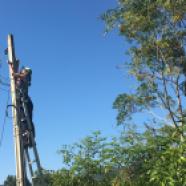The initiative “Supporting Community-led Approaches to Addressing the Digital Divide” is a project implemented by APC in partnership with Rhizomatica that aims to develop the models, capacities and sustainability of community networks.
With financial support from the UK Government’s Digital Access Programme, this project running from 2020 to 2023 will catalyse more affordable and inclusive connectivity for underserved or excluded communities in low-income rural, urban and peri-urban areas.
This initiative builds on APC’s existing local access-related work currently being implemented with the support of the Swedish International Development Cooperation Agency (Sida) to the project “Connecting the Unconnected: Supporting community networks and other community-based connectivity initiatives,” and the knowledge previously gained from the Local Access Networks research project implemented by APC and Rhizomatica, with support from the International Development Research Centre (IDRC), during the period August 2017 through January 2019.
The project will provide technical assistance, capacity building, policy and regulatory advice and community mobilisation in five priority countries: Brazil, Indonesia, Kenya, Nigeria and South Africa. It will focus on building the technical, organisational and business capacity of community network actors and facilitators at different levels. The intervention will ensure that the organisational and business models needed for sustainability are enhanced, it will enable their integration into the context of public and private sectors, and it will catalyse access to connectivity for excluded or underserved communities and vulnerable populations.
Why is this project needed?
Despite the rapid uptake of mobile phones, the connectivity divide between rich and poor countries, between urban and rural areas and between affluent and low-income communities, is increasing. There continue to be heavy infrastructure investments by national commercial operators in urban areas and in wealthy countries, while rural areas, poorer countries and marginal regions within emerging and mature markets are unlikely to benefit from similar investments.
This connectivity gap exists when sparsely populated regions with no connectivity are seen as subsistence-level households that large operators find unprofitable and thereby have little incentive to service. As a result of relying on these traditional models, bringing the economic and social benefits of effective, meaningful, safe and secure communication to all citizens continues to be a serious challenge for most countries, especially in the global South, with connectivity in rural areas likely to develop at a much slower pace, if at all.
While the problem of digital exclusion has been recognised by developing country governments for many years, sustainable and scalable solutions have struggled to emerge. The standard response by policy makers has been to incentivise or subsidise the costs of rural service provision by commercial operators, and the success of this strategy has fallen short of expectations.
Many countries have attempted to subsidise the additional costs for national operators to encourage them to extend connectivity to rural areas (such as by financing masts), but this has not proved successful, as evidenced by the continued low or non-existent levels of access in rural areas in most developing countries, and the marked plateau in global uptake of mobile subscriptions.
The expected outcomes of this project are:
-
Increased capacity and resources for individuals and organisations, in particular women, who promote digital inclusion models that provide affordable access to previously unconnected or under-connected populations (micro level).
-
Strengthened capacity of organisations that support community networks to articulate viable ways to address common barriers through shared knowledge, platforms, collective action and effective stakeholder engagement with users, industry and institutions (meso level).
-
An improved enabling policy, legal and regulatory environment for community networks as a complementary model of inclusive connectivity, combined with increased institutional capacity in this area of work (macro level).
How will this initiative approach the issue?
The “Supporting Community-led Approaches to Addressing the Digital Divide” project aims to contribute to building an enabling ecosystem for the emergence and growth of community networks and other community-based connectivity initiatives in five target countries, using an integrated approach over a three-year period.
The project will be structured in three work clusters aligned to the expected outcomes, and to the micro, meso and macro levels of intervention. In addition, these working clusters will create an ecosystem of collaboration among organisations at and across the three levels, and within the global organisations leading its implementation.
-
Consolidating, through training and mentoring, seven micro-level local organisations per target country (or a total of 35 organisations) and creating a community of practice within each country with support.
-
Strengthening and consolidating at least one meso-level organisation from each of the five target countries and building cross-country synergies through this group of organisations. With facilitation by APC and Rhizomatica, the expected result is a community of practice that will continue operating beyond the duration of the project.
-
Addressing the policy, legal and regulatory barriers faced by the micro-level local and meso-level organisations.
Read more about APC's projects on local access and community networks:
Local Access Networks: Can the unconnected connect themselves?
Read APC's content related to community networks here.
Member for
7 years
Member for
7 years 3 months
Member for
8 years 6 months
Member for
5 years 8 months
Member for
8 years 6 months
Member for
5 years 8 months
Member for
5 years 9 months
Member for
6 years 9 months
Member for
8 years 4 months
Member for
5 years 8 months
Member for
5 years 8 months
Member for
5 years 8 months
Member for
4 years 6 months
Member for
5 years 4 months
Member for
3 years 11 months
Member for
2 years 9 months
Member for
2 years 9 months
Member for
2 years 9 months
Member for
1 year 8 months
Member for
5 years 7 months